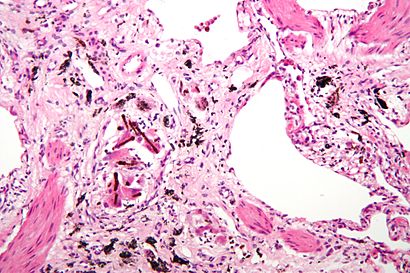Pneumoconiosis facts for kids
Quick facts for kids Pneumoconiosis |
|
|---|---|
 |
|
| Micrograph of asbestosis (with ferruginous bodies), a type of pneumoconiosis. H&E stain. |
Pneumoconiosis (say: new-moh-koh-nee-OH-sis) is a lung disease. It's not caused by germs or infections. Instead, it happens when tiny dust particles get into your lungs. This disease usually affects people who work in dusty jobs. It gets worse over time and can make it hard to breathe.
One common type of pneumoconiosis is called Black Lung Disease. This happened to coal miners who breathed in coal dust every day. Another type is called asbestosis. It's caused by breathing in asbestos fibers. A third type, silicosis, comes from breathing in tiny silica particles, like those found in sand or quartz. All these forms of pneumoconiosis can shorten a person's life. Sadly, there is no cure for them.
Contents
What Causes Pneumoconiosis?
Pneumoconiosis happens when very small dust particles get deep into your lungs. Particles that are between 1 and 5 micrometers wide are the most dangerous. They can get stuck in the tiny air passages of your lungs.
Your lungs have special cells called macrophages. These cells try to clean up the dust. But if there's too much dust, or if the dust is very harmful, these cells can get overwhelmed. This causes your lungs to become inflamed and scarred. Over time, this scarring makes it harder for your lungs to work properly. Smoking tobacco can make the effects of dust even worse.
How Doctors Find Pneumoconiosis
Doctors look for several signs to diagnose pneumoconiosis. They will ask about your job history, especially if you've worked in dusty places.
Common signs and symptoms include:
- A cough that doesn't go away
- Feeling short of breath
- A tight feeling in your chest
Doctors also use a chest X-ray. The X-ray can show special patterns in the lungs. These patterns look like patchy areas or small cysts, especially in advanced stages of the disease.
Can Pneumoconiosis Be Treated?
The damage to the lungs from pneumoconiosis cannot be reversed. This means the scarring and changes in the lungs are permanent. However, doctors can help slow down the disease. They can also help make the symptoms less severe.
Treatments might include:
- Medicines to help open up airways and reduce swelling.
- Breathing treatments to make breathing easier.
- Pulmonary rehabilitation, which is a special exercise program for your lungs.
- Extra oxygen if your lungs can't get enough on their own.
In very serious cases, a lung transplant might be needed. If a person with pneumoconiosis smokes, quitting smoking is also very important. Doctors will often do regular tests, like X-rays, to see how the disease is progressing.
How to Prevent Pneumoconiosis
Preventing pneumoconiosis is very important, especially for people in dusty jobs.
Here are some ways to prevent it:
- Wear a mask: Workers in dusty industries should always wear special masks. These masks filter out tiny dust particles.
- Clean up: Wash any skin that touches dust.
- Change clothes: Remove dust from clothing before eating or drinking. Wash your face and hands too.
- Government rules: Governments often have rules for industries, especially mines. These rules limit how much dust is allowed in the air. This helps keep workers safe.
In the United States, there's a law called the Black Lung Benefits Act. It helps coal miners who get pneumoconiosis. It gives them and their families monthly payments and medical help.
Related pages
See also
 In Spanish: Neumoconiosis para niños
In Spanish: Neumoconiosis para niños

